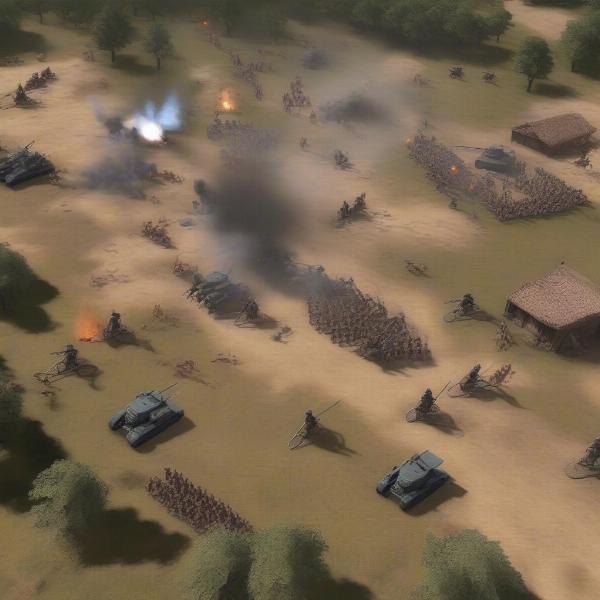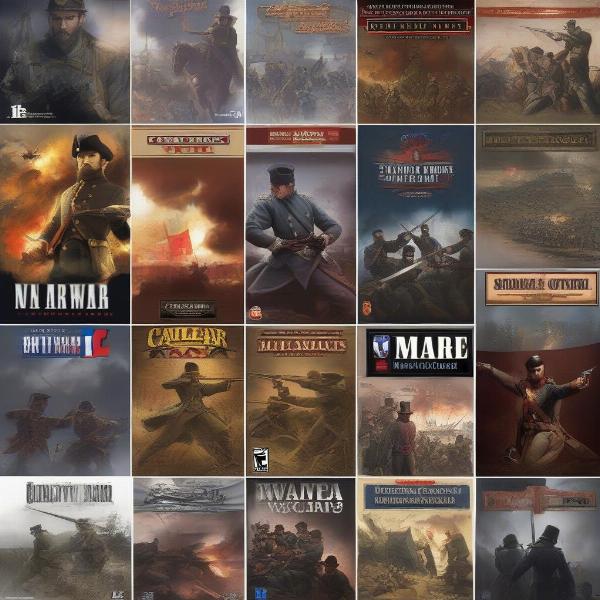The American Civil War, a conflict of immense scale and consequence, has long captured the imagination of historians and gamers alike. Here at SupremeDuelist.blog, we often delve into the strategic depths of various games, and today we turn our focus to the “War And Peace Civil War Game” genre. These games offer a unique lens through which to examine the complex military campaigns, political maneuvering, and social upheavals of this pivotal period in American history.
This exploration will not only cover the mechanics and gameplay that make these games engaging but also analyze the historical accuracy and the overall experience they provide. We’ll uncover why this particular era is so compelling for game developers and players and what makes a successful Civil War game stand out from the crowd.
The Allure of the Civil War in Gaming
Why is the American Civil War such a popular topic for video games? The answer lies in the unique blend of strategic depth and emotional weight that the conflict offers. The battlefields were not simply about tactical decisions, they also represented a clash of ideologies, cultures, and economic systems. This creates a rich tapestry for game designers to explore, presenting opportunities for varied gameplay. Unlike some historical settings, the Civil War’s scope, while large, is manageable within the context of a game, allowing players to engage in both grand strategy and smaller tactical skirmishes. It’s an era ripe for interactive storytelling and historical reenactment.
 civil war game strategic map
civil war game strategic map
What Defines a Good Civil War Game?
Several key elements contribute to the success of a “war and peace civil war game.” Accurate historical representation is paramount for immersion, covering not only the uniforms and weaponry but also the political and economic realities of the time. A strong emphasis on strategic decision-making, both on and off the battlefield, is also crucial. Players need to feel the weight of their choices, understanding how decisions impact the overall war effort. This often manifests as a blend of grand strategy map management and tactical battlefield engagements. Finally, robust artificial intelligence for opponents and the ability to engage in multiplayer scenarios are vital for replayability.
Key Mechanics and Gameplay
Civil War games employ a range of mechanics, often blending turn-based strategy with real-time tactical battles. Strategic layers involve managing armies, resources, and political influence across a map of the United States. Tactical layers focus on moving individual units across a battlefield, utilizing historical formations and tactics. The player will need to consider factors such as supply lines, weather conditions, and morale – aspects that often determined the outcome of real battles. A successful game will seamlessly integrate these mechanics, creating a cohesive and engaging experience.
Strategic Depth and Resource Management
The best Civil War games emphasize strategic planning just as much as battlefield tactics. Players often must manage resources, recruit and train troops, and oversee logistics across vast territories. The ability to control supply lines, construct fortifications, and influence the political climate is just as important as winning battles. This adds a layer of complexity, ensuring that victory is not simply about brute force, but also about careful planning and efficient resource management. Similar to the strategic choices players make in a cruise ship wars video game, the decisions regarding logistics and resource allocation are often the keys to victory.
 civil war game battle gameplay
civil war game battle gameplay
Tactical Battlefield Engagements
Tactical combat in “war and peace civil war games” generally involves maneuvering units, using cover, and managing formations. Historical accuracy is again important, with accurate representations of weapons and tactics of the era, such as the linear formations of infantry, and the limitations of artillery. Success in battle depends on the player’s ability to understand and adapt to the strengths and weaknesses of their forces and the terrain. These battles often can be complex and challenging, requiring a combination of strategic foresight and tactical finesse.
The “War” and “Peace” Dynamic
The phrase “war and peace” in the context of a Civil War game isn’t just about battles. It’s about balancing military strategy with the political and social realities of the time. Games often explore the socio-political impact of the war, showing how decisions on the battlefield affected civilian populations, economies, and morale. This dynamic adds depth and complexity to the gameplay, allowing players to grapple with the human cost of war.
Diplomacy and Political Intrigue
Many “war and peace civil war games” introduce elements of diplomacy and political intrigue. Players may find themselves trying to sway foreign powers to their cause or working to manage internal divisions within their own faction. The game could incorporate elections, political appointments, and even the abolitionist movement. These elements give a broader view of the conflict beyond simple military encounters, enhancing the gameplay and ensuring that victory requires more than just battlefield dominance.
Managing the Home Front
The home front plays a critical role in these games, with players often needing to manage economies, infrastructure, and public opinion. This adds a layer of realism, showcasing the challenges of sustaining a war effort while maintaining civilian support. Economic stability, civil morale, and even social reforms play key roles in determining the outcome of the conflict, reminding players that war is a deeply human endeavor.
Popular Titles and Their Contributions
Several games have stood out in this genre, each with its own unique contributions. From classic turn-based strategy games to more recent real-time tactical experiences, the landscape is diverse and rich. Each game has approached the Civil War from a slightly different perspective, bringing its own unique set of features, mechanics, and focus areas. This ensures a variety of options for history and strategy game enthusiasts.
 civil war game box art
civil war game box art
Specific Game Examples and Their Strengths
- [Game Title 1]: This example might be a classic turn-based game that excels at providing a deep strategic layer, where resource management and grand strategy are key.
- [Game Title 2]: Perhaps a title known for its realistic tactical battles, where players manage individual units and formations on a detailed battlefield.
- [Game Title 3]: This could be a more modern take, that blends elements of both grand strategy and tactical battles, with an emphasis on political management.
“The best Civil War games aren’t just about recreating the battles,” says Dr. Amelia Hayes, a historian specializing in the American Civil War, “they’re about understanding the interplay between military, political, and social forces during this turbulent period.”
What the Future Holds for the Genre
The Civil War game genre will continue to evolve, with developers exploring new ways to capture the intricacies of the conflict. The rise of advanced AI, improved graphical capabilities, and a more complex understanding of human behavior in wartime will allow for even greater immersion. We can expect to see more games that explore the social and political dimensions of the war, offering a more nuanced and historically accurate experience.
Frequently Asked Questions About Civil War Games
What makes a “War and Peace” game different from other strategy games?
These games often combine elements of turn-based grand strategy with real-time tactical engagements, focusing on the human side of the conflict alongside battlefield action. Similar to how players in a cruise ship wars video game need to consider resource management, these titles put a heavy emphasis on managing economics and political considerations.
How historically accurate are these games?
The accuracy varies from game to game, but generally, the better titles are meticulously researched and based on historical documents. They aim to provide an immersive experience while remaining true to the main events and the historical context.
What kind of player is this genre for?
It’s best suited for those who love strategic depth, tactical challenges, and have an interest in history, particularly the American Civil War. A love for management and a tolerance for slow, strategic thinking is a must.
Are these games difficult to learn?
Like most grand strategy games, the initial learning curve can be steep. However, once players understand the game’s core mechanics, it becomes deeply rewarding. Tutorials and active player communities help new players find their footing.
“The best “war and peace” civil war games allow players to experience history, not just observe it,” suggests Ethan Bellweather, a veteran game designer. “The goal is to make players feel the weight of decisions made in a different time period.”
Conclusion
The “war and peace civil war game” genre offers a uniquely compelling way to explore one of the most important periods in American history. By combining complex strategic gameplay with the human realities of war, these games provide a deep and rewarding experience. Whether you are a seasoned strategy gamer or a history enthusiast, there is a Civil War game out there that can offer you a new and insightful look at this monumental conflict. At SupremeDuelist.blog, we strive to provide comprehensive analysis and insights into all facets of gaming, and this exploration into the Civil War game genre is just one example of our commitment. Remember to check back for more analysis and updates on your favorite games. We’ll keep exploring the dynamic world of gaming, bringing you valuable insights and reviews.
Leave a Reply